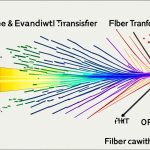Synchronous Optical Network (SONET) and Synchronous Digital Hierarchy (SDH) are critical components of modern fiber optic networks, enabling efficient and reliable data transmission over optical fibers. As the demand for high-speed and seamless connectivity continues to rise, understanding the role of SONET/SDH in these networks is essential.
SONET, a standardized digital communication protocol developed by the American National Standards Institute (ANSI), is widely used in backbone carrier networks in North America. It allows for the transmission and multiplexing of multiple data streams, significantly increasing data rates and leveraging the capabilities of optical media.
To better comprehend the importance of SONET/SDH, let’s explore their benefits, their role in multiplexing data streams, and their comparison to SDH, the international equivalent standard.
The Benefits of SONET in Fiber Optic Networks
One of the main benefits of incorporating SONET in fiber optic networks is its high level of reliability. SONET allows for the establishment of redundant paths and automatic protection switching, which ensures that data can still be transmitted even if a portion of the network fails. This makes SONET-based networks highly resilient and minimizes downtime.
Additionally, SONET enables efficient transmission of data over long distances without significant loss or degradation. Fiber optic cables already offer advantages such as low data loss and resistance to electromagnetic interference, but SONET further enhances these characteristics by providing a standardized framework for organizing and transmitting data.
The high data rates supported by SONET make it suitable for handling large volumes of traffic, including data, voice, and video. Furthermore, SONET defines interoperability standards, allowing different organizations to seamlessly connect and share data across their networks. This flexibility and versatility make SONET an ideal choice for modern fiber optic communication networks.
| Advantages of SONET in Fiber Optic Networks |
|---|
| High Reliability |
| Efficient Transmission of Data |
| Scalability and Flexibility |
| Support for Multiple Data Types |
| Interoperability Standards |
The Role of SONET in Multiplexing Data Streams
One of the key functions of SONET is its ability to multiplex multiple data streams across a fiber optic cable. In a SONET-based network, the cable is divided into separate channels or channels, each capable of transmitting and receiving data independently. This multiplexing capability allows for the efficient utilization of the available bandwidth and enables the simultaneous transmission of different types of data.
The network elements defined in SONET, such as STS multiplexers and demultiplexers, ensure that the data streams are properly separated and converted between electrical and optical signals. SONET provides a standardized framework for organizing and managing these channels, allowing for easy scalability and flexibility.
By multiplexing data streams, SONET maximizes the capacity of fiber optic cables and enables telecom operators to share data over existing infrastructure instead of laying new cables, which can be costly and time-consuming.

Benefits of SONET Multiplexing
“SONET multiplexing improves data transmission efficiency and optimizes the utilization of fiber optic cables. It enables the simultaneous transmission of diverse data types, such as voice, video, and internet traffic, over a single cable. This multiplexing technique reduces the need for additional cables, saving costs and simplifying network management.”
Scalability and Flexibility
SONET-based networks offer scalability and flexibility through the use of multiplexing. Telecom operators can easily add or remove channels to accommodate changing data requirements without significant disruption to the network. This adaptability is particularly advantageous in modern data-centric environments where data transmission demands are constantly evolving.
Reliable Data Transmission
In addition to efficient multiplexing, SONET provides built-in reliability features that ensure continuous data transmission even in the event of network failures. Redundancy and automatic protection switching mechanisms allow for rapid rerouting of data in case of fiber cuts or equipment failures, minimizing downtime and ensuring seamless connectivity.
SONET vs. SDH: A Comparison of Standards
SONET (Synchronous Optical Network) and SDH (Synchronous Digital Hierarchy) are two widely used standards for synchronous digital transmission. While SONET is primarily employed in North America, SDH is the preferred choice internationally. Both standards serve the same purpose of enabling the transmission of data over optical media, but they differ in terms of structure and framing methods.
SONET is based on the Synchronous Transport Signal (STS) hierarchy, with OC-1 as the basic unit. On the other hand, SDH uses the Synchronous Transport Module (STM) hierarchy, with STM-1 as the fundamental unit. The frame formats and speeds used in SONET and SDH vary, but both follow a hierarchical approach that allows for the multiplexing of lower-level signals to form higher-level signals.
Despite these differences, SONET and SDH are technically comparable and provide similar benefits. They both offer high data rates, reliable data transmission, and the ability to handle multiple types of data. The international adoption of SDH reflects its compatibility and effectiveness in meeting the requirements of diverse communication networks.
To highlight the similarities and differences between SONET and SDH, the table below provides a comprehensive comparison of these standards:
| Feature | SONET | SDH |
|---|---|---|
| Hierarchy | Synchronous Transport Signal (STS) | Synchronous Transport Module (STM) |
| Basic Unit | OC-1 | STM-1 |
| Data Rates | Up to 622 Mbps | Up to 155 Mbps |
| Transmission Distance | Longer distances | Shorter distances |
| Application | Primarily used in North America | International adoption |
Despite their nuanced differences, the overall goal of SONET and SDH is to ensure the efficient and reliable transmission of data over fiber optic networks. The choice between SONET and SDH depends on the specific requirements and geographical location of the network deployment. Whether it’s SONET in North America or SDH internationally, both standards play pivotal roles in supporting the ever-increasing demand for high-speed and dependable data transmission.
Conclusion
SONET/SDH technology plays a pivotal role in modern fiber optic networks, providing a reliable and efficient foundation for data transmission. By implementing SONET/SDH, network operators can harness high data rates, long transmit distances, and support for various data types offered by this standardized protocol.
SONET/SDH enables the multiplexing of multiple data streams over fiber optic cables, optimizing bandwidth utilization and facilitating seamless connectivity between different networks. Despite SONET being primarily used in North America and SDH being the international equivalent, both standards serve the same purpose and offer similar benefits.
As the demand for high-speed and dependable data transmission continues to increase, SONET/SDH will remain a critical component of modern fiber optic networks, ensuring the smooth flow of information over vast distances.
FAQ
What is SONET and how does it contribute to fiber optic networks?
SONET (Synchronous Optical Network) is a standardized digital communication protocol used for synchronous data transmission over optical fibers in North America. It allows for the transmission and multiplexing of multiple data streams across a fiber optic cable, increasing data rates and enabling the use of optical media. SONET defines various network elements and layers that facilitate the movement of signals and data across the network.
What are the benefits of incorporating SONET in fiber optic networks?
One of the main benefits of SONET is its high level of reliability. SONET allows for the establishment of redundant paths and automatic protection switching, ensuring data transmission even if a portion of the network fails. Additionally, SONET enables efficient transmission of data over long distances without significant loss or degradation. Furthermore, SONET offers high data rates, support for multiple data types, and interoperability standards for organizations.
How does SONET multiplex data streams in fiber optic networks?
SONET multiplexes multiple data streams across a fiber optic cable by dividing the cable into separate channels or channels, each capable of transmitting and receiving data independently. This multiplexing capability allows for efficient utilization of the available bandwidth and simultaneous transmission of different types of data. The network elements defined in SONET ensure that the data streams are properly separated and converted between electrical and optical signals.
How does SONET compare to SDH?
SONET and SDH (Synchronous Digital Hierarchy) are two similar standards used for synchronous digital transmission. SONET is primarily used in North America, while SDH is adopted internationally. They serve the same purpose but have different structures and framing methods. SONET is based on the Synchronous Transport Signal (STS) hierarchy, while SDH uses the Synchronous Transport Module (STM) hierarchy. Despite these differences, SONET and SDH provide similar benefits and are technically comparable.
What is the role of SONET/SDH in modern fiber optic networks?
SONET/SDH technology plays a vital role in modern fiber optic networks, providing the foundation for reliable and efficient data transmission. It enables high data rates, long transmit distances, and support for various data types. SONET/SDH also facilitates the multiplexing of multiple data streams, maximizing bandwidth utilization and enabling seamless connectivity between different networks.




















Туроператор Большой Алтай
[url=https://big-altay.ru/]заказать проститутку алтай[/url]
Команда туроператора «Большой Алтай» имеет многолетний профессиональный опыт в туристической и санаторно-курортной отрасли. Мы официальный партнер санаториев и гостиниц курорта Белокуриха. Наш офис находится в самом центре курортного кластера Белокурихи ул. Славского 29/1. , наша команда проживает непосредственно в городе-курорте Белокуриха и конечно мы обладаем актуальными знаниями о всех преимуществах и недостатках в санаториях и гостиницах курорта. Подберем для вас выгодный во всех отношениях вариант отдыха и лечения, с учетом всех требований и пожеланий по размещению и профилю заболевания.
У нас вы можете заказать групповой и индивидуальный трансфер до дверей санатория. Приобрести авиа и ж/ж билеты.
Организовываем экскурсии и туры по Горному Алтаю и окрестностям Белокурихи для гостей курорта.
У нас Вы можете приобрести Курсовку и пройти оздоровительный курс на базе Курортной Поликлиники. Также мы поможем в вопросе бронирования жилья: квартира, гостиница, гостевой дом.